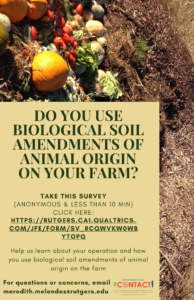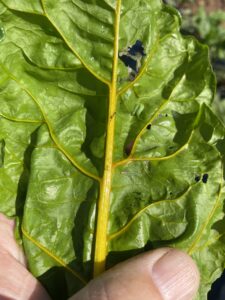If you use biological soil amendments (raw, composted, or processed) of animal origin on your fresh produce farm we would like to know more about it through this anonymous survey. Information provided will be used to inform extension educators and influence research and educational outreach nationally.
Archives for September 2023
Use soil amendments of animal origin on your produce farm? Tell us about it!
Vegetable IPM Update 9/27/23
Sweet Corn
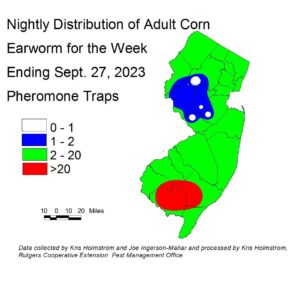 Northern and central blacklight traps and all pheromone traps continue to catch corn earworm (CEW) moths. However, the dramatic drop in nighttime temperatures following the tropical storm have significantly lowered catch numbers this week. Should temperatures moderate, we will know whether this indicates a reduced population or simply lower activity. Pheromone trap information is available from all northern and central sites, with now very limited input from southern New Jersey. We will use a combination of pheromone and blacklight trap types to derive silk spray schedules by region. We are now only able to check many traps on a weekly basis, as our student help has returned to their studies. This can give some areas an artificially high or low appearance of activity. Red areas on the pheromone trap map (at right) indicate a 3-day spray schedule. Green areas indicate a 4 day schedule. Silking corn is remains at risk of CEW infestation at this time. Be sure to access information from this publication in the upcoming weeks to determine how frequently you should treat silking sweet corn to protect it from CEW infestation.
Northern and central blacklight traps and all pheromone traps continue to catch corn earworm (CEW) moths. However, the dramatic drop in nighttime temperatures following the tropical storm have significantly lowered catch numbers this week. Should temperatures moderate, we will know whether this indicates a reduced population or simply lower activity. Pheromone trap information is available from all northern and central sites, with now very limited input from southern New Jersey. We will use a combination of pheromone and blacklight trap types to derive silk spray schedules by region. We are now only able to check many traps on a weekly basis, as our student help has returned to their studies. This can give some areas an artificially high or low appearance of activity. Red areas on the pheromone trap map (at right) indicate a 3-day spray schedule. Green areas indicate a 4 day schedule. Silking corn is remains at risk of CEW infestation at this time. Be sure to access information from this publication in the upcoming weeks to determine how frequently you should treat silking sweet corn to protect it from CEW infestation.
The highest nightly blacklight trap catches of CEW for the week ending 9/27/23 are as follows:
| Allamuchy 3 | Califon 1 | Oldwick 1 |
| Allentown 2 | Chester 1 | Princeton 1 |
| Milltown 2 | Clinton 1 | Sergeantsville 1 |
| Bellemeade 1 | New Egypt 1 | South Branch 1 |
The highest nightly pheromone trap catches of CEW for the week ending 9/27/23 are as follows:
| East Vineland 40 | Green Creek 4 | South Branch 2 |
| Georgetown 19 | Matawan 3 | Chester 1 |
| Farmingdale 14 | Califon 2 | Pennington 1 |
| Allamuchy 6 | Snyder Farm (Hunterdon) 2 | Sparta 1 |
Silking Spray Schedules*:
South – 3-4 days
Central – 4 days
North – 4 days
*These recommendations are based on regional catches. Adhere to tighter spray schedules if indicated by local trap catches. Synthetic pyrethroids alone should NOT be used for corn earworm (CEW) protection on silking corn, or for fall armyworm (FAW) management at any stage. Control with these materials is very inconsistent.
Cole Crops
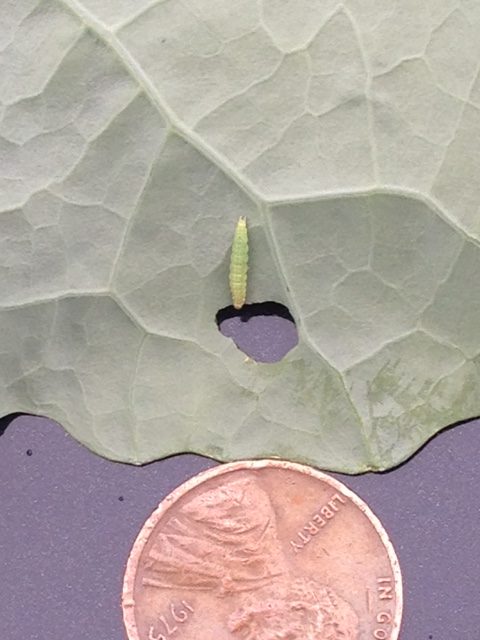 Fall plantings are now impacted by diamondback moth larvae ((DBM) see photo at right), as well as imported cabbage worm (ICW), cross striped cabbage worm (CSCW) and beet armyworm (BAW). DBM can multiply quickly, and does not respond to chlorantraniliprole (Coragen) in many parts of the state. Effective materials continue to be IRAC 5 materials (spinosyns), and the IRAC 6 material, ememectin benzoate (Proclaim). Consultants and scouts report good efficacy with the IRAC 21A, tolfenpyrad (Torac) . Be sure to check the Cole Crops Section of the 2022-23 Commercial Guide for specifics, as PHI’s and crop labels vary. It is important to return to treated fields within 2-3 days to assess the efficacy of the insecticide applications. Effective materials should eliminate DBM larvae within 48 hours. BAW will not be controlled by pyrethroids. ICW and CSCW have not shown resistance to labeled materials in our area.
Fall plantings are now impacted by diamondback moth larvae ((DBM) see photo at right), as well as imported cabbage worm (ICW), cross striped cabbage worm (CSCW) and beet armyworm (BAW). DBM can multiply quickly, and does not respond to chlorantraniliprole (Coragen) in many parts of the state. Effective materials continue to be IRAC 5 materials (spinosyns), and the IRAC 6 material, ememectin benzoate (Proclaim). Consultants and scouts report good efficacy with the IRAC 21A, tolfenpyrad (Torac) . Be sure to check the Cole Crops Section of the 2022-23 Commercial Guide for specifics, as PHI’s and crop labels vary. It is important to return to treated fields within 2-3 days to assess the efficacy of the insecticide applications. Effective materials should eliminate DBM larvae within 48 hours. BAW will not be controlled by pyrethroids. ICW and CSCW have not shown resistance to labeled materials in our area.
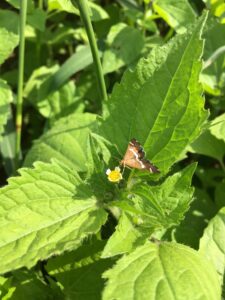 Hawaiian beet webworm (HBWW) continues to impact crops. Large numbers of moths may be found in weedy areas adjacent to host crops (photo at left). Galinsoga and pigweed patches seem to be favored by the moths. Injury to host crops (beet greens, swiss chard, spinach) has been reported from many parts of the state. Growers in all counties would be wise to check plantings of these hosts at least weekly for the presence of foliar injury. Numerous holes in leaves, with larvae on the lower leaf surfaces (photo at right). Recommended insecticides may be found in the Spinach Section of the 2022-23 Commercial Guide.
Hawaiian beet webworm (HBWW) continues to impact crops. Large numbers of moths may be found in weedy areas adjacent to host crops (photo at left). Galinsoga and pigweed patches seem to be favored by the moths. Injury to host crops (beet greens, swiss chard, spinach) has been reported from many parts of the state. Growers in all counties would be wise to check plantings of these hosts at least weekly for the presence of foliar injury. Numerous holes in leaves, with larvae on the lower leaf surfaces (photo at right). Recommended insecticides may be found in the Spinach Section of the 2022-23 Commercial Guide.
Pepper Weevil
Pepper weevil infestations appear to be down for NJ growers this year. As of this writing, only two farms are, or have been infested, both in the Vineland – East Vineland area. Given the time of year and cooling weather, pepper weevil will become less of a problem. Continue to look for small, aborted fruit, cutting them open to examine the interior for feeding damage or small grey-white grubs. Vydate (IRAC 1A) appears to be one of the better materials for trying to manage weevils, along with Actara (IRAC 4A). Never rely upon pyrethroids alone to manage weevils.
Beet Armyworm
Pheromone catches of beet armyworm are high in some southern NJ areas at this time. 65 moths per night in East Vineland have been reported. 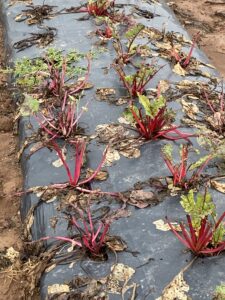
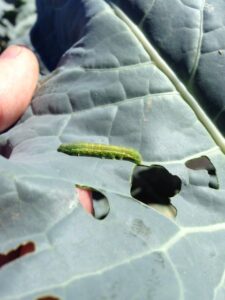 Additionally, BAW larvae have been found in cole crop plantings northward to Hunterdon County this week. While numbers are not high in these areas, their presence points to possible higher infestations in southern parts of the state. This pest (photo at near left) has the ability to defoliate pepper plants and damage fruit, and can cause severe damage on other crops (see photo of chard at far left). BAW is resistant to pyrethroid insecticides, and other materials should be used in response to infestations. Effective materials include spinosyns (IRAC 5) and diamides (IRAC 28).
Additionally, BAW larvae have been found in cole crop plantings northward to Hunterdon County this week. While numbers are not high in these areas, their presence points to possible higher infestations in southern parts of the state. This pest (photo at near left) has the ability to defoliate pepper plants and damage fruit, and can cause severe damage on other crops (see photo of chard at far left). BAW is resistant to pyrethroid insecticides, and other materials should be used in response to infestations. Effective materials include spinosyns (IRAC 5) and diamides (IRAC 28).
Timely Reminder Conditions A Perfect Storm For Lettuce Tip Burn
Yesterday as we started the 5th or 6th day of cloudy, wet, high-humidity weather, my inbox had an article from producegrower.com on preliminary results of trials at The Ohio State University by Dr. Chieri Kubota, Director of the Ohio Controlled Environment Agriculture Center (OHCEAC) and Professor in the Department of Horticulture and Crop Science, and one of her graduate students, PhD candidate John Ertle. They rated the sensitivity of 20 lettuce cultivars to prime conditions to induce lettuce tipburn, exactly the conditions we’ve had this past week.
As they reported, “Tipburn is caused by calcium deficiency often seen in lettuce (Lactuca sativa) when plants are grown quickly under optimum environmental conditions. The deficiency is also known as “localized” around young leaves at the shoot tip. Therefore, tipburn occurs even with sufficient calcium fertilization of the whole plant.”
While their work was conducted for Controlled Environment Ag (CEA) production, conditions in field production can and often does replicate the controlled environment they created to induce tipburn (same issue with Blossom End Rot of tomatoes, peppers, and eggplants). Namely, “conditions that promote overall plant growth (high light, high CO2) yet suppress plant transpiration rate (low air circulation, high humidity) are known to increase the risk of tipburn. In addition, low humidity (high VPD) during nighttime increases tipburn risk in some cases.”
[Citing some of her own work, Kubota explained,] “This is because low humidity at night promotes non- stomatal transpiration (loss of water from leaf surface), reducing xylem pressure and calcium supply to the shoot tip at night.”
The Ohio State team compared various cultivars supplied by different seed companies under controlled growth conditions to induce tipburn and reported significant differences in the severity and time to beginning of symptoms, ranging from 0 to 58%. Yields were not correlated with tipburn incidence.
Researchers in California reported in Overview of Tipburn of Lettuce that their field studies also found significant differences in tipburn severity among cultivars. Richard Smith et al. concluded, “The greater issue for the development of tipburn in lettuce is the variety,” and that “persistent foggy conditions that reduce transpirational flow of calcium to all parts of the leaves in the last 6-10 days prior to harvest will trigger this disorder in sensitive varieties.”
Unfortunately, studies to find effective controls of tipburn indicate little can be done, including having adequate Ca in soils and foliar applications of Ca during the growing season. The Ca just doesn’t get to the rapidly growing tissue in time to reduce the damage. The general conclusion is to conduct your own field trials to determine best varieties for your farm.
Reminder Insect Pests / Entomology 101 – this Wednesday night.
September sessions-
PLEASE LOG IN EARLY
In preparation for 2024 Nursery IPM training we invite ALL growers (nursery, greenhouse, Christmas tree, vegetable, row crops, landscape professionals) to attend the following educational sessions surrounding overall plant health and pest management principals.
NOTE: These free virtual sessions (on Zoom) will count as “in-person”, meaning all attendees will receive offered CEUs if they: have a live video feed (and are visible the entire time), upload a government issued photo ID + NJ Pesticide license prior via a secure Rutgers Connect folder (follow directions below, only the agents will have access to information for verification), and participate in poll questions.
Government issued photo ID and NJ Pesticide License upload:
- Click here to upload BOTH your government issued Photo ID and Pesticide License prior to the meeting
- Upload directions: If you click on the photo ID upload link using a smart phone/tablet you will have the option of simply taking a photo of your ID and uploading it directly into the system. Otherwise, you can scan a copy of your photo ID into a computer and follow the directions at the upload link. If you are unable to upload documentation prior to the meeting, please contact Tim Waller for assistance (twaller@njaes.rutgers.edu).
- Please upload files of your photo ID and applicator license to the link above as; “Last name_ First_ Photo ID” AND “Last name_ First_ Pesticide License”
Sessions: (You must register for each session individually, but only need to upload ID material one time for this series)
Date: 9/27/2023 (W) – Entomology 101 – Tim Waller, Cumberland County RCE
- Click here to register for Entomology 101
- Time: 6:00 – 7:00pm (5:30-6:00pm sign-in)
- NJ Pesticide CEU’s: 1A (2) – 3A (2) – 3B (2) – 3C (2) – 10 (2) – PP2 (2)
- Tim Waller will be discussing the basics of insect biology (entomology) as it relates to horticulture. Developing a baseline understanding of which are troublesome pests and which are beneficial will aid in pesticide management decision making approaches across horticulture.
